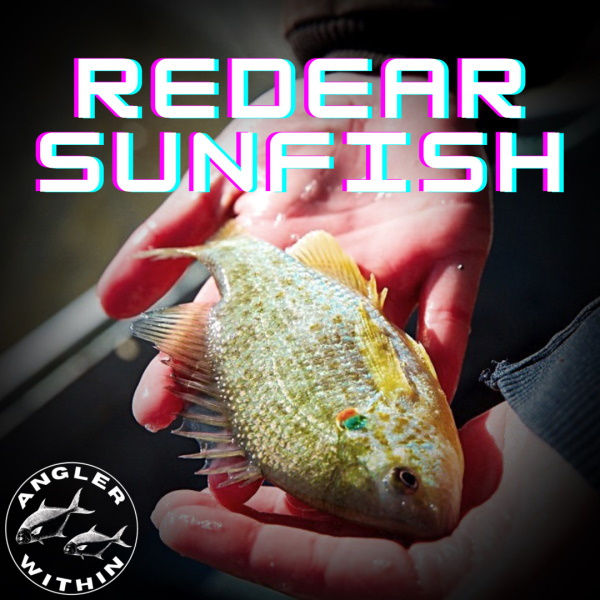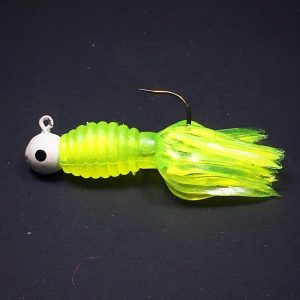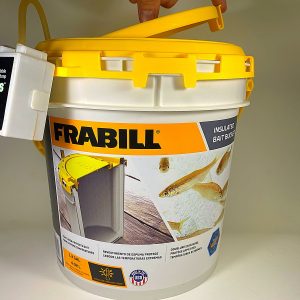
Redear sunfish aka Shellcracker Bream are like bluegills on steroids. For consistent redear success you’ll have to target them differently than their bluegill cousins.
Like most fish, the best time to catch them is during their annual spawn, which occurs about a month earlier than the bluegill spawn. Begin targeting shellcrackers around March or April by sending red worms to the bottom. That’s where you’ll typically find redear, as they predominantly forage for food along the bottom. Still waters, such as lakes and reservoirs, with good water clarity and some vegetation are typically the best locations.
Let’s discuss in detail where and how you can catch redear sunfish.
What Is A Shellcracker?
Shellcrackers are one of the more common members of the sunfish family. They are the 2nd most popular sunfish, falling just behind the much renowned bluegill. They’re also sometimes referred to as “chinquapin”, but the most accurate name for this feisty panfish is the “redear sunfish” (Lepomis microlophus).
Shellcrackers have a reddish or orange crescent moon shaped spot around their gill flaps. This noticeable marking is what caused them to get tagged with the common name of “redear”. They live to around 6 years old and can commonly get to over 3 pounds!
The largest redear sunfish ever recorded was 5 pounds, 12 ounces. In comparison, the largest bluegill was 4 pounds, 10 ounces.
Redear are “Shell Crackers”!
What makes a redear bream so special is it’s ability to crush the shells of certain food items that might not be available to other sunfish. They have pharyngeal teeth, or “crushers”, in their throat that allow them to grind up the hard shells of snails and other mollusks.
Because they don’t eat all the same forage as a bluegill, for example, they can cohabitate quite nicely with both bluegill and bass.
Bluegill vs Redear Sunfish
Redear Grow Larger Than Bluegills
Redear are not typically as abundant as bluegills, but they do get bigger. A size of up to 3 pounds is not uncommon, particularly in the deep south.
Shellcrackers Can Handle Higher Salinity
Interestingly, redear can withstand higher salt content than bluegills. So, they’ll actually become more prevalent and outnumber bluegills as salt content increases. Therefore, in bodies of water that connect to coastlines, for example, they will likely be more common than bluegills, which isn’t normally the case elsewhere.
Just as with other sunfish species, there is such a thing as a hybrid bluegill/redear mix.
Redear Sunfish Are Harder To Catch
Redear are generally more challenging to catch than bluegill. This is because they are not as prolific of a spawner, and they typically inhabit deeper water.
Shellcrackers don’t have as elongated of a spawn as a bluegill does. Therefore, they disperse post-spawn, and retreat to deeper water earlier in the year than their cousins. This results in a narrower window of easy pickings, whereas a bluegill may offer plentiful shallow water opportunities for 3 months or more.
Redear Sunfish vs Pumpkinseed Bream
These 2 species are similar in appearance and are often confused. Pumpkinseed have curvy lines on their gill cover that helps to distinguish them.
Redear seem to thrive better than pumpkinseed sunfish in the same waters, as they seem to be better foragers of similarly preferred food items. Therefore, where you find the two together, redear will commonly outcompete pumpkinseed for food and thus suppress their numbers.
Best Baits For Redear Sunfish
As they approach adulthood, shellcrackers typically feed on mollusks, such as snails and mussels, or insects. They will also supposedly feed on small fish. With that said, great baits are those readily available natural options, such as worms, mealworms or crickets. Red worms, in particular, are a really good bait, but nightcrawlers dug from your own backyard are good as well. You should cut larger worms into halves or thirds and thread them onto the hook without bunching them up.
Although smaller baits are generally better, sometimes upsizing your offering (using a larger chunk of worm) can actually produce more bites. Something to consider if you aren’t getting the bites you want.
Some people do use artificials to entice these fish, but fake baits are certainly not as effective for this species as they might be for others. I always choose to stick with natural baits for any bream fishing.
Best Times to Catch Shellcrackers
Like most fish, the best time to catch shellcrackers is during their annual spawn. Redear begin to spawn in the spring when the water temps hit about 66 degrees. However, ideal fishing temps are more around the 70-74 degree mark.
The redear spawn occurs before the bluegill spawn kicks off. So, don’t wait too late to start your search for them, as you may miss the magic window altogether. Once the spawn is over, they’ll return to deeper waters. These pre and post spawn water depths are deeper than most other sunfish use. This is part of what makes redear so difficult to catch outside of the spawn.
The best months to target redear will vary by state, but generally spring to early summer is the best window. This would be March and April in the south, and more like May and June further north. A good way to look at it is that you should be searching for them about a month before the traditional bluegill spawn in your area.
Where To Find Shellcracker Bream
To be able to catch shellcracker, you’ll obviously need to be fishing where they exist. Fortunately for you, shellcracker are a very wide ranging fish, and have even been introduced into many states where they are not native.
Range
Their native range is mostly in the southeast United States, but they can now be found beyond that range, including, but not limited to the states of California, Arizona, Illinois, Indiana, Virginia and Ohio.
Location Specific Information
You can use the info below to give you clues on what type of body of water you might find them in. Alternatively, you can search the web for something like “best Arkansas lake for shellcrackers”. The answer to that query happens to be Bear Creek Lake in east Arkansas’ St. Francis National Forest.
You can do web searches for any state to give yourself a good starting point. However, to get better location-specific search results for your region, you can include the word “forum” on the end of your search topic (i.e. “best Arkansas lake for shellcrackers forum“). Such a search will take you right to the source of the information you need – the local anglers themselves.
Best Type Of Waters
Redear bream do not prefer a lot of current. Therefore, you’ll usually find them on the bottom of ponds, lakes, reservoirs and other such calm waters. You won’t find them in the fast flowing water of creeks or rivers, but they may be present in slower moving sections or in the backwater areas of such places.
Redear sunfish prefer bodies of water that have some vegetation. Grassy lakes rich with mollusks are ideal. This desire for crustaceans is what has obviously contributed to their nickname – “shell cracker”.
Depths And Structure
As mentioned above, redear sunfish like to hang out along the bottom of all types of freshwater impoundments and slow moving waters. They tend to relate to deeper depths as compared to other sunfish in the same area. The actual depth will depend on the particular body of water that you are fishing, and could be as deep as 30 feet or more.
You should search for redear bream anywhere that you can find hard or soft cover. Stumps, treetops, logs, grasses, lilly pads and other vegetation all potentially attract concentrations of redear.
Where To Find Spawning Redear
Submerged points in 1 to 10 foot of water with some type of hard cover, such as stumps or treetops, are great spawning spots. Keep moving until you find them. Don’t waste 20 minutes in the same area with no bites. You may need to slowly drag your bait along the bottom to find and catch them. Most spawning beds will typically be found in water depths of 3 feet or more, so that’s a good place to start your search.
Gear For Redear Sunfish
Obviously many setups will work fine for bream fishing, so I’ll just give a recommendation. That’s all it is, nothing more. Don’t let anyone tell you there’s a “best” rig for bream fishing. Honestly, that’s ridiculous.
Clear Water Setup
Because shellcracker seem to thrive best in bodies of water with good water clarity, that means you may have to be stealthy with your approach. For me, that means casting to them when the water is clear.
I prefer a very light action 6′ to 7′ rod with a compatible spinning reel spooled with 2-4 lb. line. A #2 hook with half a worm works great. Many other combos will work for this, just don’t use too large or too visible of a fishing line. If needed, you can always tie on a lighter weight leader than your mainline.
Stained Water Setup
When the water is more dingy, you can get away with the cane pole approach. I don’t actually like cane poles, but instead prefer a more modern and lengthy crappie style jigging rod. Just as with fishing with a cane pole, you will swing your bait out into the target zone rather than casting with a reel. This is a very efficient way to fish if you can get away with the close proximity required to use this method.
Terminal Tackle For Redear
Hook & Worm
You’ll have best results in clear water if you avoid any extra tackle in your rig. A simple #2 to #4 hook with a piece of worm is one great option. Don’t use a sinker unless you have to. Certainly, you don’t have to use a bobber for redear fishing in shallow clear water. Mostly you’ll be fishing with your bait on or near the bottom, so many times you can exclude a bobber from your setup. Watch your line for any movement, and try to feel the bait for bites.
Drop Shot Rig
Another great setup for redear is a dropshot style rig with a weight on the bottom, and the bait suspended 5-10″ up from the sinker. With this rig, your bait will be very near the bottom which is exactly where you need it. You don’t need actual drop shot weights. Just use pinch on weights or small bell sinkers, or whatever else you already have.
Sinker Above Hook
You can also effectively fish with the sinker above the hook, but with no bobber. Slowly drag your rig along the bottom trying to keep your lead weight in constant contact with the bottom. The advantage of using a lead weight in your setup is that you can sort of feel the bottom. When you get to any grassy areas, slow your retrieve down even more. Shellcrackers love vegetative areas.
Using Bobbers
You can opt for a bobber in certain situations, but it’s not my preference. One interesting use of a bobber for redear is as a bite indicator only, rather than a suspension device. What I mean is the bobber is free sliding on the line with your bait actually on the bottom. The bobber provides a visual indicator for when you get a bite. it won’t go under, but it will move to let you know there is activity on your hook.
Other Gear For Bream Fishing
Make sure you bring along something to collect your catch with. Bring a stringer, bucket, or a cooler. You’ll likely want to keep a few for dinner!
You’ll also need a pair of needle nosed pliers or forceps for hook removal. Those mouths are pretty small, so you won’t be able to get your fingers in there to get a deep hook out.
Are Redear Bream Good To Eat
As with any species of bream or “brim”, redear are a great tasting fish. Because they skew to a larger size than many other sunfish, you have the option of fileting them, which is always my preference. You can also cook them whole which I’ll admit is a great option, if eating your way around the bones doesn’t bother you. A little cornmeal and some grease in a cast iron skillet is a sure fire winner.
Conclusion
Redear are a very interesting panfish that is very deserving of their “game fish” tag. Like all bream, they are feisty hard fighters that taste amazing.
Because shellcrackers are a little “different” than most other sunfish, this makes them a little more of a desirable species to target. In fact, I’m certain that they, instead of bluegill, would be sitting atop the sunfish world, if only they were more abundant and wide ranging.
Happy Fishing!
Augustus Clay
If you enjoyed this article, you might also like this one – Best Baits For Bluegill



